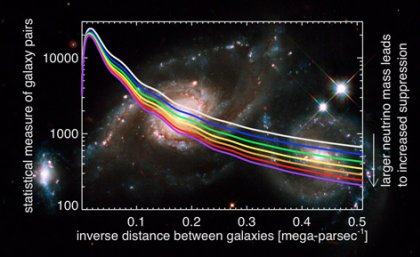
The lightest known subatomic particles in the Universe are now able to be more accurately scrutinised, in light of new astronomic research two years in the making.
After more than 200 nights of galaxy-gazing and thousands of calculations, an international team of astronomers, including researchers from The University of Queensland, has published a new study that has made a remarkable headway in the way the mass of neutrinos are measured.
The study, published in the May edition of Physical Review D Rapid Communication concludes that cosmological galaxy measurements are more effective than laboratory experiments on Earth when it comes to constraining neutrino mass for measurement.
Neutrinos are the subatomic-sized fundamental particles floating in the Universe and the lightest massive known particles, yet they are traditionally treated as not having any mass.
Lead author of the study, Dr Signe Riemer-Sørensen of the UQ School of Mathematics and Physics, said this new study would allow researchers to gain a more accurate and highly sensitive picture of neutrino mass, and this could ultimately lead to new understandings of the Universe.
“This research paves the way for more sensitive future galaxy surveys to understand the mysterious workings of the Universe, and will help in new advancements such as improved models of supernova explosions and in designing neutrino telescopes that can probe much more distant objects than classical telescopes,” said Dr Riemer-Sørensen.
Although laboratory experiments on Earth so far have been able to measure the differences in the masses between the various species of neutrinos, they have been unsuccessful in measuring the absolute neutrino mass with sufficient sensitivity.
Using the Universe as a large particle physics experiment, the team in this study attempted to limit the range of possible neutrino masses by understanding how galaxies form.
“One of the major challenges is that galaxy formation is not well-described theoretically,” said Dr Riemer-Sørensen.
“We have tested a range of previously used theories and demonstrated that most of them are not precise enough to use with present and upcoming galaxy surveys with the much-desired higher level of sensitivity to the neutrino mass.”
Using high-quality data from the team’s WiggleZ Dark Energy Survey -- a massive three-dimensional galaxy map of 240,000 galaxies -- the researchers in this study applied a mixture of analytical modelling and simulation to achieve their results.
“Despite the modelling challenges, cosmology does a much better job than laboratory experiments when it comes to constraining the neutrino mass,” said Dr Riemer-Sørensen.
The team is currently working on refining the neutrino mass measurement by combining their results with other independent data sets, such as measurements from other astronomical observations.
Other researchers in the study are Professor Michael Drinkwater, Dr Tamara Davis and Dr David Parkinson, all from the UQ School of Mathematics and Physics, as well as researchers from Australia, USA, South Africa, and Canada.
More information: The paper, The WiggleZ Dark Energy Survey: Cosmological neutrino mass constraint from blue high-redshift galaxies, by Riemer-Sørensen et al., can be viewed online here.
Media: Dr Signe Riemer-Sørensen (07 3365 8213, signe@physics.uq.edu.au) or SMP Communications Officer Aarti Kapoor (07 3346 9935, a.kapoor@uq.edu.au)
.jpg)


